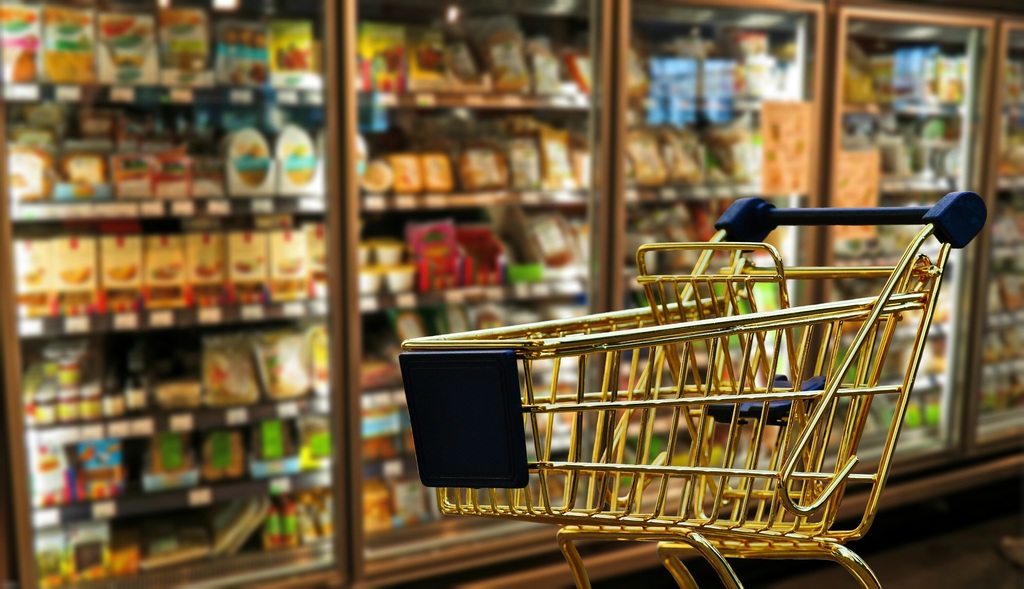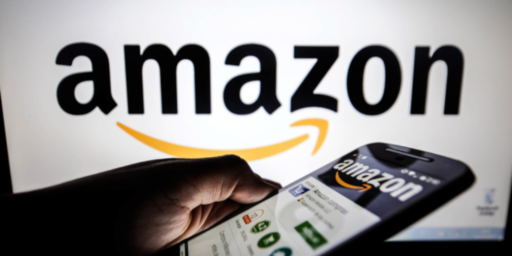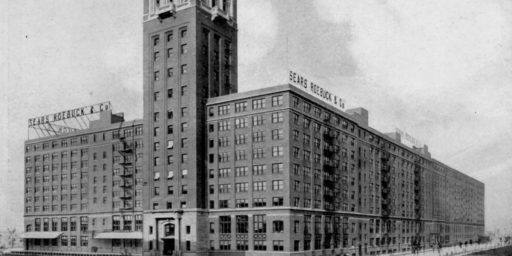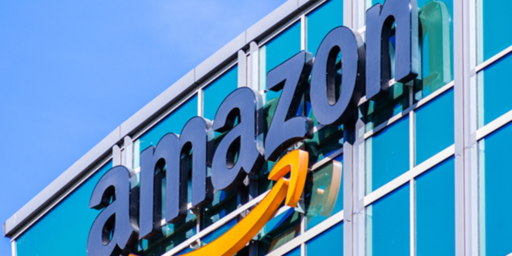Amazon Ends ‘Just Walk Out’ Grocery Checkout
Spying on customers is expensive.

Gizmodo (“Amazon Ditches ‘Just Walk Out’ Checkouts at Its Grocery Stores“):
Amazon is phasing out its checkout-less grocery stores with “Just Walk Out” technology, first reported by The Information Tuesday. The company’s senior vice president of grocery stores says they’re moving away from Just Walk Out, which relied on cameras and sensors to track what people were leaving the store with.
Just over half of Amazon Fresh stores are equipped with Just Walk Out. The technology allows customers to skip checkout altogether by scanning a QR code when they enter the store. Though it seemed completely automated, Just Walk Out relied on more than 1,000 people in India watching and labeling videos to ensure accurate checkouts. The cashiers were simply moved off-site, and they watched you as you shopped.
Instead, Amazon is moving towards Dash Carts, a scanner and screen that’s embedded in your shopping cart, allowing you to checkout as you shop. These offer a more reliable solution than Just Walk Out. Amazon Fresh stores will also feature self check out counters from now on, for people who aren’t Amazon members.
“We’re rolling out Amazon Dash Cart, our smart-shopping carts,” said an Amazon spokesperson to Gizmodo. Amazon confirmed this feature is replacing its Just Walk Out technology in existing stores.
Just Walk Out was first introduced in 2016, presenting Amazon’s biggest and boldest innovation in grocery shopping. The technology seemed incredible, but there were some stumbles. It often took hours for customers to receive receipts after leaving the store, largely because offshore cashiers were rewatching videos and assigning items to different customers. The system of scanners and video cameras in each store is also incredibly expensive.
According to The Information, 700 out of 1,000 Just Walk Out sales required human reviewers as of 2022. This widely missed Amazon’s internal goals of reaching less than 50 reviews per 1,000 sales. Amazon called this characterization inaccurate, and disputes how many purchases require reviews.
“The primary role of our Machine Learning data associates is to annotate video images, which is necessary for continuously improving the underlying machine learning model powering,” said an Amazon spokesperson to Gizmodo. However, the spokesperson acknowledged these associates validate “a small minority” of shopping visits when AI can’t determine a purchase.
Amazon Fresh, the e-commerce giant’s grocery store first launched in 2007, has just over 40 locations around the United States. The company also owns Whole Foods, and many of Amazon Fresh’s experiments are seen as precursors for the large chain.
There is an Amazon Fresh location not far from me and I’ve shopped there two or three times. While the “walk out” technology is interesting and the stores generally hassle-free, I found the selection wanting and the prices high compared to the Safeway and Giant stores that abound.
But, I must confess, I did not know until this morning that there was a trove of workers in India spying on customers. Indeed, before the local store opened, I remember reading stories like this May 2022 entry from Stuff‘s Connor Jewiss (“Why Amazon Fresh’s ‘just walk out’ tech is the shopping experience we all need“):
The last major innovation to in-person shopping was contactless payments, but that’s old news now. These Amazon Fresh stores are entirely checkout-less, allowing you to, quite literally, just walk out. Packed with all sorts of clever tech, we’re going inside one of the stores to find out how they work, and if they’re any good.
How do Amazon Fresh Stores work?
When you walk into an Amazon Fresh store, things couldn’t be simpler. Just fire up the Amazon app on your phone, head to the basket, and hit Fresh Code just under the search bar at the top. You’ll then see a QR code pop up on your display. Scan this at the turnstiles, just like you’d scan a boarding pass at the airport.
[…]
In order to provide the “just walk out” experience, Amazon needs to know what you’re purchasing and when you leave. It sounds simple, but it’s fairly complicated in reality.
To track where you are, Amazon has installed an array of hundreds of cameras into each Fresh store. They follow you around the shop, but there’s no facial recognition involved. Everything gets processed in store or on the app, and all data gets deleted within 30 days. The smart shop just needs to know where you are.
These same cameras are watching what you pick up and put back, too, so Amazon knows exactly what you buy. There aren’t any giant barcodes on products for the cameras to spot. Rather, they use AI to identify items and where they are in the store to confirm if that’s correct. You wouldn’t be picking up toothpaste in the sandwich isle, would you?
In addition to the cameras, each shelf includes a weight sensor. The sensor detects when you pick an item up, and can work out what it is based on the weight. The AI combines this data with the rest to really make sure it’s got the right products.
And when you’re ready to leave? Head back to the gates, which swing open ready for your departure, like your own personal doorman. There’s a station for you to pack your bags, and for cutlery if you purchased any food items in store. Amazon will automatically charge your preferred card as you exit, and you can carry about your day as usual. Head into your inbox or the app for a receipt.
[…]
Can they be tricked?
Amazon’s so sure that the tech can’t be beaten, there’s not even an option to add products it missed in the app. You can remove items you didn’t purchase, but not add ones you did. That sounds like a challenge to us! Summoning my inner Indiana Jones, I went around the Amazon Fresh store to see what I could nick.
In true Raiders of the Lost Ark fashion, I tried the old switcheroo trick with two similar bottles of water to see if the weight sensors could be fooled. Alas, Amazon Fresh correctly worked out which bottle I took in the end.
Similar tests proved just about as effective – as in not at all. Throwing an item into the Amazon-branded bag as fast as possible didn’t fool the cameras. Picking something up and putting it back didn’t either. Nor did putting it back in the wrong place (which I corrected at the end because, those people).
I vaguely recall a similar article about an intrepid reporter trying the old switcheroo trick with organic and non-organic produce with the same result.
While some folks on the Internet suspected that Amazon was using human spies, most just assumed that Amazon’s AI technology was just that good. Apparently, so did Amazon. Not so much, it turned out.






Last year, at the baseball stadium, I found myself in a similar setup. You scanned your credit card as you walked in, got your stuff and then just walked out. There was an attendant there and I asked where I could see what the store was charging me for. The answer involved downloading an app and registering my credit card and then the “receipt” showed up in that – 16 hours later. Needless to say, never went back and don’t even know if it is still there, as it was in a part of the stadium I’m not normally at.
It is amazing the lengths corporations will go to avoid having to hire American workers for their outlets.
I use the Dash Carts each time I go to an Amazon Fresh store. I find it convenient and easy. BUT, I’ve stoppd gong to Amazon Fresh for anything except their tuna steaks. Everything else I find more expensive than the Albertson’s, Jon’s, or Vallarta Markets nearby. Plus I like ethnic foods and Amazon Fresh is pretty much ‘non-ethnic” across the board.
The bean counters will be the death of us all.
I dislike using the self checkout, as I feel I’m doing work for the store and so I should get paid for it. I’m more ambivalent about scanning items that go in the cart, though I haven’t had a chance to do that as yet.
And then there’s ATMs. I don’t mind them as such, but lately banks are forcing their customers to use them, even when it’s ridiculous. For instance, I cashed a payment order at the bank the other day. Part of the money was for petty cash, the rest was a reimbursement I was owed. So there I am, right at the teller cashing out a paper, and I ask him to deposit my part to my account.
Guess what he said. Deposits under X amount are not allowed at the window, and have to be done at the ATM. So, after waiting in line to cash the order, I now have to wait in line to use the ATM? What kind of customer service is that?
Just because you can doesn’t always mean you should. I stopped embracing new technology with the IPad. No regrets.
I shop in person maybe three times a year, the rest is all Instacart. In the area of online groceries, Amazon Fresh is almost useless.
@Kathy: Tangent: I’ve been using ATM’s for 40 years, almost exclusively for withdrawals, and I always count my money when it comes out. The machines have never made a mistake.
Just moved to Portland, OR, recently and walked by the empty storefront that used to be the Amazon Fresh store. Checked with Google to see where one was; it directed me to two Amazon Warehouses.
@MarkedMan:
I used ATMs to deposit my salary back in the 90s. Back then, I couldn’t go to the bank during business hours, and I got paid in cash. It was different, too, as the machines then couldn’t identify and cash bills. You needed a special envelope where you wrote down account number, name, date, amount, etc. And you had to trust the bank would record it accurately. I don’t recall having any issues with that.
I wouldn’t have a problem making a deposit on an ATM these days, either. What bothers me is being at the teller window already, and being denied a banking service.
The checking account that I have today still has the same account number from when I opened the account at the local Home Federal Savings and Loan in 1983. Since then my account has been handed off to Charter Bank then Magna Bank then Union Platers and is now with Regions since 2008. I don’t remember when I got my first ATM card. Sometime in the ’90s maybe? However I know it was not issued by Home Federal. Only once, maybe 6 or 7 months ago did an ATM fail me. It was one of the machines right at the bank. Went through the routine but no money. The door for the cash dispenser never opened. It did print me out a receipt that showed $20 debited from my account. I went inside and explained to a teller what had occurred. She told me there would be an investigation and filed a claim. Four business days later $20 was credited to my account.
“Just Walk Out was first introduced in 2016, presenting Amazon’s biggest and boldest innovation in grocery shopping.”
This hardly seems like an innovation. Stop-and-Shop/Giant chains have had a check-out-as-you-go since the late 200s, at least. You get a little hand scanner, scan-and-bag, then pay at a self-check terminal on your way out. Did the carts eliminate that final step? If not, it doesn’t seem like anything that wasn’t already being done.
I like this option. It actually helps with budgeting and such since you see in real time what your bill is and whether discounts are being applied and whatnot.
ETA: D’oh! I misread the article. The JWO technology was indeed an innovation. The Dash Carts or whatever are more akin to the tech I was describing. I got mixed up about which was which.
@Kazzy:
Yes. Hence, “just walk out.” The store tabulates what you owe and then charges your card—often hours later.
@MarkedMan: I’ve had an ATM make a certifiable mistake. It wasn’t off by a huge amount but it was off and the bank confirmed it when the machine was counted later.
@Mister Bluster:..Union Platers…
Union PLANTERS..
Good grief. That only took 2 1/2 hours to detect.
I recall promo videos when Amazon launched these stores. It was a while ago. They made it seem not just convenient and seamless, but also instantaneous. In the videos, the shopper takes items and sees their card charged correctly as soon as they step out the store.
If people had high expectations, Amazon has only itself to blame for that.
BTW, there was an earlier attempt at something like this, without scanners in carts, making use of RFID tags. I think IBM might have been involved in it, but nothing ever came off it. Though RFID tags are still in use, largely to make the alarm sound at the exit if they aren’t removed or deactivated. they’re not found in all items. I think they’re also used to track inventories in warehouses.
Somewhat related, there have been attempts in casinos to automate craps. It’s a labor intensive game, requiring three to four dealers. The idea was for players to input bets on a terminal, then roll the dice over a pristine table, which would be read by overhead video equipment. I saw this at Vegas at two places and played it. A fair deal of the time, the sole dealer wound up inputting te dice value manually. Tracking two dice is far simpler than hundreds of items.
What took off is a similar concept known as bubble craps. There are individual terminals at a circular table, and a bubble at the center has two oversize dice that can always be read. It requires no dealer at all. The bubble makes the dice shake and tumble, and when the player pushes the button they jump in the air. It’s very random.
That became my favorite way to play craps. For one thing, you could sit. For another, it was easier to ignore other players making bad bets.
@Kathy:
so, they’ve monetized the old kids’ game Trouble? Awesome!
@Flat Earth Luddite:
Back in my childhood days, children played a simple card game called war. Pretty much it was whoever drew the higher card wins.
There’s Casino War available in Vegas.
@Kathy:
This is the commercial and game that came to my mind.
https://youtu.be/HfznucMwNuU?feature=shared
I suspect war has been around as long as pasteboard cards, or longer.
@Flat Earth Luddite:
I don’t recall that game, but I do remember some board games with bubble dice.
Dude, you’re in a public place, in someone else’s business. Watching what you are doing is not “spying”. At all. Seriously. Any more than if they had 27 store monitors following you around.
Similarly, the red light camera that sends you a ticket for running a red light on a public street is not “spying” on you. You’re in public! P-u-b-l-i-c. Look it up.
At least 20 years ago, stories were published about a pending revolution in retailing which would replace bar codes with some kind of microdot readable at a distance. Shopping trolleys would keep track of your purchases and automatically charge your credit card when you left the store. It sounds like the predictions were a bit premature, but might finally be coming to pass.
@DrDaveT: Yes stores for years have been issuing receipts itemising exactly what you bought, so I don’t see how the Amazon system was gathering any new information.
I do go to the Amazon Fresh store near my office on occasion, but only for the salad bar, which is actually quite good. It is also convenient to be able to pick up a few grocery items while I am there. I have done this maybe 20 times over the past 18 months. My observations:
1. The place is typically dead whenever I go in there during the early afternoon. Typically, there are only 2-3 other customers in the store and I don’t think I have ever seen customers outnumber employees. In fairness, I have never been there at night or during other times of day or on weekends. But the strong impression I get is that there is no way in hell that this store is profitable.
2. While salad bars are commonly a loss leader for a grocery store, this has to be especially true at this store. I typically don’t get lunch until at least 1:00 PM and I am often pretty obviously one of only a very small number of people who have touched the salad bar and I occasionally have seemed to be the first.
3. I have not paid too much attention to prices, but agree with Mr. Joyner about selection. Quite simply, it isn’t good and there is no way in hell I would use this store as my primary grocery store if I lived nearby. There are just too many things that I commonly buy that they don’t seem to carry.
4. My receipts, when received, have usually been accurate but on at least two occasions they have undercharged me (didn’t charge for an item) and on one occasion overcharged me for an item that I not only didn’t buy, I didn’t even go anywhere near. Getting that item refunded was an easy process, however.